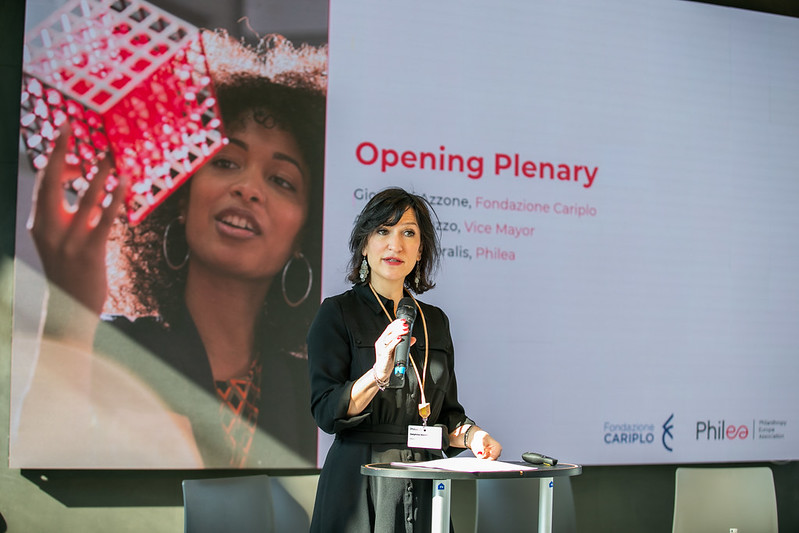Italian philanthropic tradition stretches back to ancient Rome. Modern Italian philanthropy, however, recently flourished in the 1990s when savings bank foundations emerged. Today they collectively hold half of all Italian philanthropic assets, or 21 per cent of the European total.
However, Italian philanthropy has remained somewhat of an enigma from an outside perspective.
In the heart of Milan, the Cariplo Foundation (Fondazione Caripolo) – an organisation that emerged from the savings banks dotted across Lombardy – hosted this conference in a former factory-turned-startup space. Here, Philea’s research forum laid its foundation for the coming two days to discuss how philanthropy breaks out from its own silos to create innovation.
It’s a buzzword that, despite years of covering multiple sectors as a journalist, I have failed to get to grips with. Perhaps because those that throw the word ‘innovation’ around themselves aren’t aware of how they are using it.
In the world of philanthropy, keynote speakers laid down the reasons why philanthropy should be regarded as ‘innovative’. Foundations have an important part to play in innovation, in seeing what gaps are, in driving ecosystems.
‘Leonardo Da Vinci is the best testimony for this conference. He broke barriers between tech and arts, he is the most inspiring guy for the future of our continent,’ said Giovanni Azzoni, the president of the Cariplo Foundation.
Anna Scavuzzo, deputy mayor of Milan, spoke of innovation as closing ‘the distance between institutions, between the work of the public and private, through philanthropy’.
Philea CEO Delphine Moralis provided a much-needed pause for thought, warning that Europe could do better.
‘The European Union spends below its target on research and development, below the US and Japan. The EU market remains fragmented. That stops good ideas reaching their full potential,’ she said, adding that Philea is pushing philanthropy ‘to innovate’.
Innovation, innovation, innovation… What is it?
The idea that philanthropy could learn from startup culture, though intriguing, seemed counterintuitive. Firstly, the question begs, what on earth is innovation? The definition keeps changing depending on context.
‘Sometimes people confuse innovation with invention,’ said Alberto Sangiovanni-Vincentelli, chair of electrical engineering and computer sciences at the University of California, Berkeley. Apple, he said, didn’t invent anything new. They innovated logistics.
His idea was that the startup culture exhibited by Silicon Valley’s didn’t come from the tech companies, but the varied ecosystem surrounding them. Innovation cannot be forced; it must arrive organically. Boston, for example, is home to two large universities. Research and development fostered universities filtered their way outside; into conferences, into patent distributions. The embryonic startup culture was born, fed by researchers working close by.
Controversially, a point was delivered of how ‘moving fast is key’. In the following session, called ‘purpose driven innovation’, ‘going hard and fast’ was mentioned, too. Some pushback came from the audience.
Should philanthropies be thinking in the same vein as swashbuckling Silicon Valley startups? My instinct, matched by some audience participants, went against the magnetic pull Silicon Valley. In my view, these are ecosystem that have spawned monsters that have done huge damage to democracy, spawned a toxic culture of bullying and discrimination arguably born from its profit-first landscape, and ultimately, has done little to think about equitable redistribution.
Day two of the conference provided an antithetical vision and answered my fears. In a talk discussing ‘the power of partnerships’ James Wilsdon, executive director at the Research On Research Institute and a professor of research policy at University College London, hit the nail on the head. ‘The Silicon Valley model of innovation is highly problematic as it doesn’t lead to broadly shared prosperity’, he said. A keynote speaker dared to speak about the key issue.
‘The dominance of Silicon Valley (and increasingly China) in global innovation policy obscures other models that are better at linking innovation to prosperity,’ said Wilsdon.
Meanwhile, the state plays a vital role in distributing the benefits of innovation led growth. Policies for innovation and broadly shared prosperity are mutually reinforcing, too.
Wilsdon points to a case study of the green town of Leoben, in southern Austria: 25,000 population, with an economy based on steel and mining. Is it an example of postindustrial decline and discontent?
No! Today, Leoben is pleasant and prosperous, ‘an example of Austria’s economic success’; from 1998-2016, it saw the 2nd largest increase in research and development intensity, by comparison to any OECD economy (after S Korea). Combined with low rates of inequality, it makes Austria a success story.
Austria lags behind conventional Silicon Valley metrics. But it is grounded in a model of social partnership (public, private, third sector plus philanthropy).
‘Those that allow diffusion and focus on redistribution and public service delivery,’ adds Wilsdon. Painfully, that is not usually seen as part of innovation.
In between the keynote end and the Silicon Valley beginning, Philea’s Milan conference delved into a fragmented philanthropic landscape in Europe. Understanding philanthropy as a part of innovation. Foundations are a hub knowledge. Italian philanthropy is a key example of localised expertise because, for decades, organisations like Cariplo emerged from ‘place based’ origins strongly linked to territory.
There are many hurdles to go. Sevda Kilicalp, head of research and knowledge at Philea, says foundations ‘don’t define themselves as research and innovation funders. They see it as a means, not as an end.’ Foundations in Europe ‘don’t talk to one another’. And so innovation in Europe has become ‘characterised by few well known large foundations with substantial budgets.’
Europe is known for its single market. For research and innovation, however, it is fragmented. Ultimately, philanthropy is about connections – and connecting.
Philea’s call for Europe to provide a single market to facilitate cross border philanthropy and tax incentives on cross border collaborations are worthy and necessary changes that policymakers must hear.
Ultimately, innovation is a verb. A doing word that involves fostering connections between, as mentioned on day two, ‘diverse people, places and forms of expertise’. Of more open dialogue and partnerships where philanthropy can work for public good.
That’s the innovation that most of us working outside the hungry profit spaces want to see.
Shafi Musaddique is the news editor at Alliance magazine.








Comments (0)